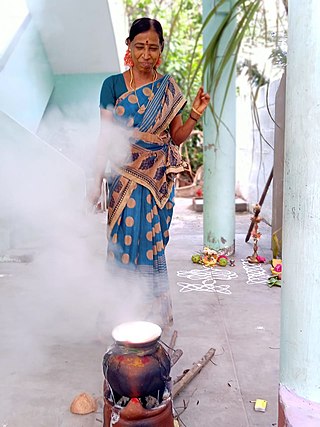
Pongal, also referred to as Thai Pongal, is a multi-day Hindu harvest festival celebrated by Tamils. It is observed in the month of Thai according to the Tamil solar calendar and usually falls on 14 or 15 January. It is dedicated to Surya and corresponds to Makar Sankranti, the Hindu observance celebrated under many regional names throughout the Indian subcontinent. The festival is celebrated over three or four days with Bhogi, Surya Pongal, Mattu Pongal and Kanum Pongal, observed on consecutive days.
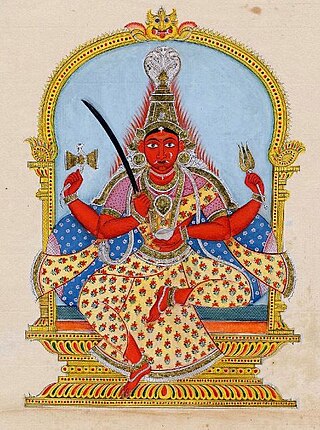
Mariamman, often abbreviated to Amman, is a Hindu goddess of weather, predominantly venerated in the rural areas of South India. Her festivals are held during the late summer/early autumn season of Ādi throughout Tamil Nadu and the Deccan region, the largest being the Ādi Thiruviḻa. Her worship mainly focuses on bringing rains and curing diseases like cholera, smallpox, and chicken pox. Mariamman is worshipped in accordance with local traditions such as Pidari or the Gramadevatai. She is considered as a guardian deity by many South Indian village-dwellers.
Arts and architecture in India have had their course shaped by a synthesis of indigenous and foreign influences that have consequently shaped the course of the arts of the rest of Asia, since ancient times. Arts refer to paintings, architecture, literature, music, dance, languages and cinema. In early India, most of the arts were derived Vedic influences. After the birth of contemporary Hinduism, Jainism, Buddhism, and Sikhism arts flourished under the patronage of kings and emperors. The coming of Islam spawned a whole new era of Indian architecture and art. Finally the British brought their own Gothic and Roman influences and fused it with the Indian style. They have a culture infusion in their art.

Indian classical dance, or Shastriya Nritya, is an umbrella term for different regionally-specific Indian classical dance traditions, rooted in predominantly Hindu musical theatre performance, the theory and practice of which can be traced to the Sanskrit text Natya Shastra. The number of Indian classical dance styles ranges from six to eight to twelve, or more, depending on the source and scholar; the main organisation for Indian arts preservation, the Sangeet Natak Academy recognizes eight: Bharatanatyam, Kathak, Kuchipudi, Odissi, Kathakali, Sattriya, Manipuri and Mohiniyattam. Additionally, the Indian Ministry of Culture includes Chhau in its list, recognising nine total styles. Scholars such as Drid Williams add Chhau, Yakshagana and Bhagavata Mela to the list. Each dance tradition originates and comes from a different state and/or region of India; for example, Bharatanatyam is from Tamil Nadu in the south of India, Odissi is from the east coast state of Odisha, and Manipuri is from the northeastern state of Manipur. The music associated with these different dance performances consists many compositions in Hindi, Malayalam, Meitei (Manipuri), Sanskrit, Tamil, Odia, Telugu, and many other Indian-Subcontinent languages; they represent a unity of core ideas, and a diversity of styles, costumes and expression.
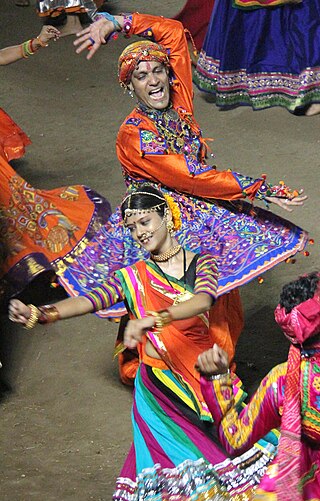
Garba is a form of Gujarati dance which originates from the state of Gujarat, India. The name is derived from the Sanskrit term Garbha. Many traditional garbas are performed around a centrally lit lamp or a picture or statue of the Hindu goddess Durga. Traditionally, it is performed during the nine-day Hindu festival Navaratri. Either the lamp or an image of the Goddess, Durga is placed in the middle of concentric rings as an object of veneration.

Dance in India comprises numerous styles of dances, generally classified as classical or folk. As with other aspects of Indian culture, different forms of dances originated in different parts of India, developed according to the local traditions and also imbibed elements from other parts of the country.
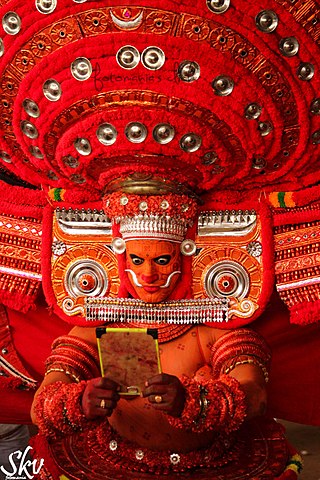
Theyyam is a Hindu religious ritual practiced in northern Kerala and some parts of Karnataka. Theyyam is also known as Kaḷiyāṭṭaṁ or Tiṟa. Theyyam consists of traditions, rituals and customs associated with temples and sacred groves of Malabar. The people of the region consider Theyyam itself as a channel to a god and they thus seek blessings from Theyyam.

Indian folk music is diverse because of India's enormous cultural diversity. It is sung in various languages and dialects throughout the length and breadth of this vast nation and exported to different parts of the world owing to migration.

The culture of Kerala has developed over the past millennia, influences from other parts of India and abroad. It is defined by its antiquity and the organic continuity sustained by the Malayali people. Modern Kerala society took shape owing to migrations from different parts of India and abroad throughout Classical Antiquity.
Kummi is a folk dance, popular in Tamil Nadu and Kerala in India, danced mostly by South Indian women in circle. Dancing may be different. In some places, it is very simple, with rhythmic clapping or beating of the drums. In other places dancers imitate various harvesting activities. Kummi often accompany by songs, called "Kummi songs". It is often danced during festivals. It is also danced by Tamils of Sri Lanka. Kummi songs became a popular addition to kuthiyottam festivities in modern times.

The urumi is a double-headed hourglass drum from the state of Tamil Nadu, South India. Two skin heads are attached to a single hollow, often intricately carved wooden shell. The preferred wood is jackwood, although other woods like rosewood may be used. Both left and right heads are usually made from cow hide that is stretched around a thin metal ring. The outer circumference of each head is perforated with approximately seven to eight holes. The two heads are held in tension by a continuous rope that is woven around the drum in a V-shape pattern. Additional small coils of string or metal are tied around each pair of ropes near the left head. These coils can be slide horizontally along the length of the drum, increasing or decreasing the tension between the heads as necessary. For example, during the monsoon season the drum heads will slacken so much that the instrument becomes unplayable. Using these coils drummers can easily rectify such problems.
Dance forms of Tamil Nadu elaborates the various dance forms originated and practiced in the Tamil Nadu, the southernmost state of the India. Tamil Nadu is the home of the Tamil people, who speak Tamil language, one of the oldest surviving languages with archaeological evidence pointing to the Tamilakam region being inhabited for more than 400 millennia and more than 5,500 years of continuous cultural history. Hence, culture have seen multiple influences over the years and have developed diversely. With its diverse culture, many forms of individual and group dances have their origins in the region and are practiced.
Tamil culture is the culture of the Tamil people. The Tamil people speak the Tamil language, one of the ancient languages in the world. Archaeological evidence points to the Tamilakam region being inhabited for more than 400 millennia and has more than 5,500 years of continuous cultural history. Hence, the culture has seen multiple influences over the years and have developed diversely. With Tamils migrating world-wide, the culture has become diverse and forms a significant part of the life of the people in India and other regions with significant Tamil diaspora such as Sri Lanka, South East Asia and Caribbean.

Navaratri is an annual Hindu festival observed in honor of the goddess Durga, an aspect of Adi Parashakti, the supreme goddess. It spans over nine nights, first in the month of Chaitra, and again in the month of Ashvin (September–October). It is observed for different reasons and celebrated differently in various parts of the Hindu Indian cultural sphere. Theoretically, there are four seasonal Navaratri. However, in practice, it is the post-monsoon autumn festival called Sharada Navaratri. There are 2 Gupta Navaratris or "Secret Navaratris" as well, one starting on the Shukla Paksha Pratipada of the Magha Month and another starting in the Shukla Paksha Pratipada of Jyestha Month.

Pana Sankranti,, also known as Maha Bishuba Sankranti, is the traditional new year day festival of Odia people in Odisha, India. The festival occurs in the solar Odia calendar on the first day of the traditional solar month of Meṣa, hence equivalent lunar month Baisakha. This falls on the Purnimanta system of the Indian Hindu calendar. It therefore falls on 13/14 April every year on the Gregorian calendar.

Parai also known as Thappattai or Thappu is a traditional percussion instrument from South India. It is a traditional instrument used to make announcements and played during festivals, folk dances, weddings and functions. The instrument in played predominantly by Tamil people in Tamil Nadu and other regions with significant Tamil diaspora such as Sri Lanka. There are many variants of the instrument, but generally consists of a drum made of wood, open on one side and closed with a stretched animal hide on the other side along with two wooden sticks used for beating the drum.
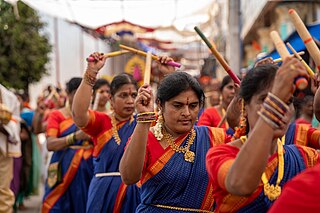
Kolannalu or kolkolannalu, 'stick dance', is one of the most popular dance narratives in the Southern part of India.

Tharai or Thaarai is a wind instrument from South India. It is a traditional instrument played during festivals, folk dances, weddings and functions. The instrument in played predominantly in Tamil Nadu and in some parts of Kerala. There are many variants of the instrument, including longer and shorter versions, curved or straight and the outer pipe may be made of metal or wood. The instrument might be played along with Thappattai, a percussion instrument in folk dances and festivities or accompanied by traditional Thavil and Nadaswaram in rituals and functions.













